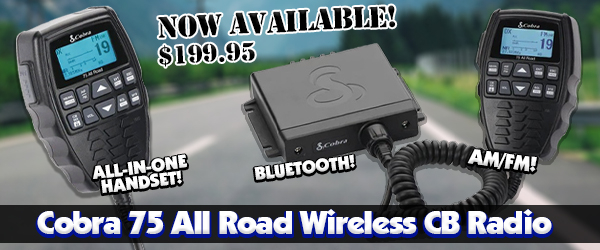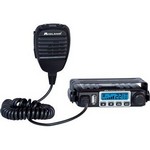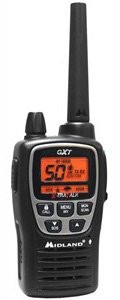 Updated March 30, 2021
Updated March 30, 2021
We frequently get questions from business customers asking if they really need to buy a "business" two way radio. Business radios are generally much more expensive than consumer radios and the features are often very similar, so it is easy to see why this can be confusing. In this post I'll try to explain the common differences between these types of radios, and hopefully provide enough information for you to decide what's best for your business.
FCC Regulations
Whether a 2 way radio is "business" or "consumer" is decided by the service and frequencies that it uses to transmit and receive communications. For instance, in the case of the FRS and GMRS radio services, the Federal Communications Commission (FCC) has set aside 22 UHF frequencies as general simplex frequencies for use by consumers on these services. These frequencies make up GMRS and FRS channels that are supported by those types of consumer radios that we sell.
Technically, while FRS radios are considered license free, use of the GMRS radios requires an FCC license. This license is good for 10 years and covers the applicant and his/her immediate family. At one time GMRS licenses were issued to businesses, but this is no longer the case. Here is a note from the FCC's GMRS license application form (form 605):
Note: For GMRS: effective January 1, 1989, new or major modification applications may NOT be filed by non-individual (business) applicants/licensees. (See Rule 1.929(c) (4) & 95.5(b).
For GMRS radios to be legally used by businesses, each person using the radios would need an individual GMRS license ($70 each). A business could use the radios on FRS channels 1-7 and 15-22 without a license at up to two watts, but when using FRS channels 8-14 the radio cannot transmit at more than a half watt of power. This is generally only good for a quarter to a half mile of outdoor range on those specific channels.
Business radios use different frequency ranges on the same UHF band as FRS and GMRS. These frequencies have been approved by the FCC for business use. The business frequencies are not as popular, so you typically don't have to worry about "chatter" on your channels. You can also get business radios that operate on VHF frequencies, which work better than UHF outdoors or inside of and around wood structures. An FCC license for your business starts at around $140, depending on the type of license. You will pay more upfront for your business radio, but if there are several employees that will use it you will likely save money after factoring in the license cost.
Durability
Business radios are usually designed to hold up to abuse better than consumer radios. Consumer radios are usually built for infrequent use: weekend hunting trips, multiple car caravans, skiing, camping, amusement parks, etc. They are usually lightweight with a thin plastic casing. Business radios are designed to be used for hours every day, and they will hold up better than consumer radios. Many are built to military specifications.
Two exceptions to this are the DeWALT branded walkie talkies and the Wouxun KG-805F. These are professional grade FRS radios capable of transmitting at up to 2 watts. They are built for consumer or business use, with powerful battery options for hours of uptime, commercial grade housings, and higher Ingress Protection (IP) ratings for dust and water resistance.
Battery Life
If your business plans to use radios for more than a few hours a day, battery life is something that you will not want to overlook. Most consumer radios include rechargeable batteries that are good for 8 hours or less of use. As is typical of batteries, this life will likely diminish slightly over time. Some business or professional radios are also limited in their battery life, but most will provide 12 hours or more on a charge.
Accessories
Business radios typically have a better selection of accessories than consumer radios. If accessories such as headsets or earpieces are important to your business, you should look at what accessories are available before you choose a radio. Things like rapid chargers and multi unit chargers are generally only available for business radios.
Common Scenarios
There are some scenarios where a business radio is always your best choice. For example, anytime you expect to use the radio frequently and for more than 8 hours with each use. If you purchase a consumer radio for this, there is a good chance you will be disappointed with the battery life. Also, if you are in a "tough" work environment such as a construction or industrial situation, with very few exceptions, consumer radios are not designed to take this kind of beating.
It may be best to choose a consumer radio in a light-duty situation where very little range is needed. This would allow you to get away with only using the FRS radios and avoiding the license fees. A great example is a school that needs radios for directing traffic in mornings and afternoons.
I hope this has been helpful. If you have any specific questions you can, as always, feel free to call or email us!
Related Resources
Buyer's Guide - Business Radios
Common Business Radio Uses/Industries
The Two Way Radio Show TWRS-02 - An Introduction to Business Radios
The Two Way Radio Show TWRS-07 - Comparing Small Business Radios






 Updated March 25, 2021
Updated March 25, 2021 You may have noticed that most of the consumer two-way radios you see around advertise a range of up to 30 miles. The truth is, consumer
You may have noticed that most of the consumer two-way radios you see around advertise a range of up to 30 miles. The truth is, consumer 
